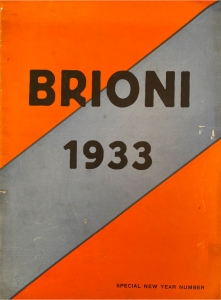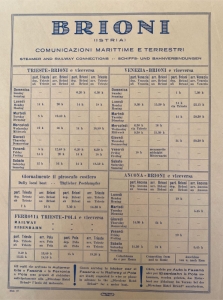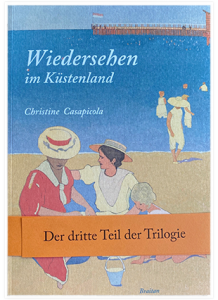The Brionian Islands/Brijuni form part of the Austrian Riviera, which stretched from Trieste to Pula along the Istrian coast. In 1850, the Habsburgs made Lošinj their summer residence, and in 1860 Archduke Maximilian completed his summer palace at Miramare near Trieste. Paul Kupelwieser bought the Brionian Islands in 1893 in order to create a new “Capri” in that environment, favoured by the mild climate, which allowed an almost year-round season. He drained the marshes, fought malaria with the support of Robert Koch, uncovered the remains of a Roman imperial villa and created hotel complexes, a marina and other modern tourist facilities. The proximity to the important ports of Pula and Trieste and the associated good traffic connections contributed to the success of Kupelwieser’s project. Until the First World War, Brioni developed into one of the most popular holiday destinations of the European Haute Volée. Under Mussolini, the islands fell to Italy.
With the marriage of Maria Anna Kupelwieser and Manfred I Mautner Markhof (April 17, 1926), the history of Brioni was linked with that of the Mautner Markhof.
Excerpts from the memoirs of Manfred I Mautner Markhof
Brioni, that fabulous island was owned by my wife’s family and founded by my grandfather, Paul Kupelwieser. He was an outstanding man. Relatively early, at about 50 years of age, he retired as an industrialist – as general director of Vítkovice he had brought that steelworks to its heyday – and bought the malaria infected island of Brioni in the Adriatic Sea, about 750 ha in size. With the help of his friend Robert Koch, the famous malaria researcher, the island was fever-free in no time at all, and nothing more stood in the way of opening up that treasure. Hotels with a large, covered swimming pool with warm sea water were built around the small harbour – at that time something quite unusual- as well as over a hundred kilometres of streets, an 18-hole golf course, two polo courses, tennis courts, etc. The island was also a popular destination for tourists. At the suggestion of Carl Hagenbeck, a large animal park was created, which was also used to acclimatize freshly caught African animals. Later, hares, pheasants, roe deer, mouflons and fallow deer were set free in the wilderness on the island, breeding brilliantly, but not exactly to the advantage of the magnificent flora. A third friend of Paul Kupelwieser’s was Rudolf Diesel, the inventor of the engines named after him; Paul allowed him to install the first diesel engine ever built into a ship in order to serve traffic with the mainland, therefore with the Pula military port. That ship, which could carry about 100 people, fulfilled its duties in an incredibly reliable manner until the beginning of the Second World War. After the death of Carl Kupelwieser (1925) – grandfather Paul had already died in 1919 – the property passed into the hands of my wife and her two younger sisters. The administration was taken over by a friend of the family, an officer of the Royal Austrian Navy, Dipl.-Ing. Pietro Cunoldi.
The increasing interest of the high society and the growing popularity of the island all over the world during the time between the two wars also meant that one could always meet important and extremely well-known people there: In the case of Polo, among many others, it was Lord Mountbatten, the Duca di Spoleto or Prince Ulrich Kinsky who never put on a helmet but only a red silk cap, Baron Louis Rothschild and Prince Otto Windisch-Graetz (grandson-in-law of the old Emperor Franz Joseph). My most interesting tennis partners were probably Count Toni Arco, who had shot the Bavarian Prime Minister Eisner on the open road in Munich and still got away alive, and Comte Sibour, one of the most successful French fighter pilots of the First World War. It is incredibly interesting to leaf through the guestbook of my mother-in-law, who was an exceptionally smart and inspiring woman. So, it happened once that the greatest living geniuses of the written word and of music on the one hand and the strongest pugilist on the other met for tea at my mother-in-law’s old Castell: George Bernard Shaw – Richard Strauss – boxing world champion Gene Tunney. The island visitors, and particularly its female inhabitants, were much excited when the English Mediterranean fleet visited Brioni. The sight of sometimes more than twenty units of the English Navy anchoring in the Fažana Strait off the island was very impressive. Men who did not have a uniform on the island at that time were clearly a second-class species. Cocktails, dinners and dancing balls alternated.
Times were getting increasingly challenging. The American Wall Street Crash of 1929 brought catastrophic cuts in hotel visits. But that was not the only reason for great concern; a trial that had been going on since 1919 for the repayment of a large loan taken out during the First World War also took an eventful course. After our opponents had changed four times, the Italian state finally faced us. After very difficult negotiations, brilliantly conducted by Dipl.-Ing. Cunoldi, the time had come for Cunoldi and me to have a two-hour conversation with the then responsible Minister Suvich in Rome, in which the timely repayment of the controversial loan was recognized and everything seemed to be settled. To be on the safe side, we drew up a protocol in Italian immediately after the meeting, had it stamped by the Secretary of Minister Suvich, Marcellino Principe del Drago, and confirmed its accuracy. With that document, I drove back to Vienna with triumphal feelings, where we gave a champagne dinner full of joy. Exactly ten days later the bad news came that everything was lost. I immediately drove back to Rome, where the then Minister Buffarini showed me the half-metre-thick act that Mussolini had to be presented with, in which he had written an “un brutto scherzo” in pencil across the act, as I read with my own eyes. According to the prevailing fascist legal opinion, Brioni’s transition into Italian state hands was thus final and determined. After the end of the war, all of Istria, including Brioni, went to the Yugoslav state. Thus, our hope for a recourse against Italy because of endured fascist inconvenience had to be given up. And, of course, there exists no justified claim against Yugoslavia, either.
On the occasion of Marshal Tito’s visit we were introduced to him and his wife Jovanka, which resulted in a long conversation. I told him in all sincerity that the grandfather of my wife, Paul Kupelwieser, the founder of the island paradise of Brioni, would certainly be pleased to see how beautiful and well-kept the island was if he could still see it today. (We had been there a few months before then as guests of Tito, but without meeting him on that occasion, and had been able to visit the whole island. But we left a little earlier, although we had been welcomed with the greatest possible hospitality, as the memories coming were a little too painful for my wife). Tito smiled at those appreciative words on my part and said, “Yes, but I made a mistake, I should not have rebuilt the hotels, which were completely destroyed during the war.” This remark, just from Tito’s mouth, really amused me. He himself lived in a newly built large villa on a magnificent square. The old Castell, which used to be the residence of my wife’s family, remained completely indestructible. A museum with more or less valuable things that had been found on the island during excavations was set up there. One room is intended as a Kupelwieser memorial, with all kinds of pictures and documents, which, of course, mainly date back to the time before the First World War, when Brioni still belonged to Austria. To our greatest surprise, we also found there a picture of our wedding on the island from 1926, apparently to emphasize the Austrian element. That Brioni has ever been Italian territory is not evident from the documentation shown.




